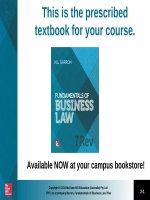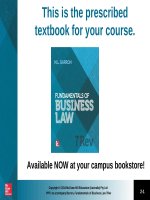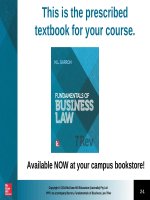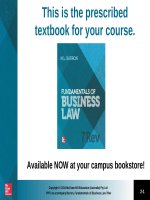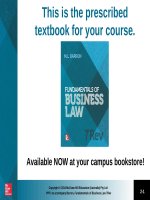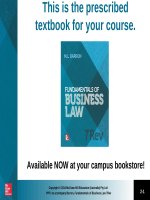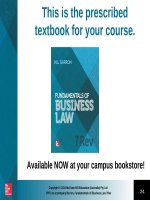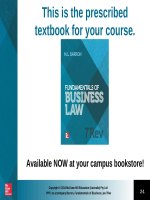- Trang chủ >>
- Thạc sĩ - Cao học >>
- Luật
Lecture Fundamentals of business law (7/e): Chapter 10 - M.L Barron
Bạn đang xem bản rút gọn của tài liệu. Xem và tải ngay bản đầy đủ của tài liệu tại đây (682.42 KB, 41 trang )
This is the prescribed
textbook for your course.
Available NOW at your campus bookstore!
Copyright © 2014 McGraw-Hill Education (Australia) Pty Ltd
PPTs to accompany Barron, Fundamentals of Business Law 7Rev
•2-1
Property law:
mortgages, leases
and licences
Chapter 10
Copyright © 2014 McGraw-Hill Education (Australia) Pty Ltd
PPTs to accompany Barron, Fundamentals of Business Law 7Rev
•2-2
Learning objectives
At the end of this chapter you should
understand:
• the definition of the term ‘mortgage’ and the distinction
between old title mortgages and Torrens system
mortgages
• the remedies available to a mortgagee if a mortgagor
defaults
• the definition of a personal property security
• the statutory provisions for the registration of security
interest in goods
• the terms ‘pledge’, ‘pawnbroker’, ‘lien’, ‘guarantee’, and
‘indemnity’
Copyright © 2014 McGraw-Hill Education (Australia) Pty Ltd
PPTs to accompany Barron, Fundamentals of Business Law 7Rev
•2-3
Learning objectives (cont.)
• the term ‘bailment’ and its differences from other
legal relationships
• the difference between a gratuitous bailment and
a non-gratuitous bailment
• the duties of bailees and bailors of goods
• the ways that a bailment may be terminated
• the liability of common carriers and innkeepers.
Copyright © 2014 McGraw-Hill Education (Australia) Pty Ltd
PPTs to accompany Barron, Fundamentals of Business Law 7Rev
•2-4
Introduction
• People can hold an interest in real property.
• Often money is lent and real property is used as
security for the loan.
• The resulting contract is called a mortgage.
• If personal property is used to secure a loan, a bill
of sale is prepared.
• Alternatively, goods may be held by way of security.
Bailment is the transfer of goods from one person
to another with the intention that the goods will be
returned to the owner at a later date.
Copyright © 2014 McGraw-Hill Education (Australia) Pty Ltd
PPTs to accompany Barron, Fundamentals of Business Law 7Rev
•2-5
Distinction between real property
and personal property
Real property
Land
Items attached to land
Leases
Personal property
(not real property)
Chattels that can be
possessed (tangible objects)
Chattels that cannot
be possessed (intangible objects)
• interest in partnership
• copyright
• shares
• trademarks
Copyright © 2014 McGraw-Hill Education (Australia) Pty Ltd
PPTs to accompany Barron, Fundamentals of Business Law 7Rev
•2-6
Distinction between ownership of
property and possession of property
• Ownership
– Person has legal rights over the property.
Owners are said to have ‘title’ to the property.
• Possession
– Person has physical control over the property.
Copyright © 2014 McGraw-Hill Education (Australia) Pty Ltd
PPTs to accompany Barron, Fundamentals of Business Law 7Rev
•2-7
Real property—attachments
Test
Fixtures
Fittings
(part of real property for
sale purposes)
Manner of attachment
Permanent
Purpose of
attachment (intention)
Damage resulting to
remove
Can be easily removed
For enjoyment of the
item
Major damage
Copyright © 2014 McGraw-Hill Education (Australia) Pty Ltd
PPTs to accompany Barron, Fundamentals of Business Law 7Rev
Minor damage
•2-8
Interests in land
• Doctrine of tenure
– Absolute ownership is not possible
as all land is owned by the Crown.
Copyright © 2014 McGraw-Hill Education (Australia) Pty Ltd
PPTs to accompany Barron, Fundamentals of Business Law 7Rev
•2-9
Estates in land
Freehold
• Interest in land of uncertain duration
– Fee simple
– Interest continues, provided owner dies leaving an heir
– Life estates
– Created for the life of a particular person
Leasehold
• Contract in the form of a lease for a fixed period between
two parties:
lessor (landowner)
lessee (tenant).
Native title
• Title enjoyed by descendants of the original inhabitants
Copyright © 2014 McGraw-Hill Education (Australia) Pty Ltd
PPTs to accompany Barron, Fundamentals of Business Law 7Rev
•2-10
Freehold estates
Reversion
Remainder
A (Fee simple of land)
A (Fee simple of land)
on
B’s
death
B (Life estate of land)
B (Life estate of land)
on B’s death
C
Copyright © 2014 McGraw-Hill Education (Australia) Pty Ltd
PPTs to accompany Barron, Fundamentals of Business Law 7Rev
•2-11
Leasehold estates
• ‘Leasehold interest’ in land is created
by the formation of a lease.
• This is a contract between two parties:
– lessor (landowner)
– lessee (tenant).
• Lease gives the lessee exclusive
possession of real property for a fixed
period in exchange for payment (rent).
• Regarded as an estate in land.
Copyright © 2014 McGraw-Hill Education (Australia) Pty Ltd
PPTs to accompany Barron, Fundamentals of Business Law 7Rev
•2-12
Definitions
• Lease: an interest in land given by a landlord
to a tenant, for a fixed period of time, granting
exclusive possession, e.g. lease of shop,
house.
• Licence: a contractual right to do something
on land that would otherwise be illegal, e.g.
– to agist stock upon a neighbour’s land
– to regularly set up a market stall on local council
land.
Copyright © 2014 McGraw-Hill Education (Australia) Pty Ltd
PPTs to accompany Barron, Fundamentals of Business Law 7Rev
•2-13
Comparison of lease and licence
Lease
• Can be registered on
title
• For a set period
Licence
• Cannot be registered
on title
• Can be revoked at
any time
• Right to sublet, assign
or sell unexpired
portion with landlord’s
consent
• Right to exclusive
possession
• Right to sue in
trespass
Copyright © 2014 McGraw-Hill Education (Australia) Pty Ltd
PPTs to accompany Barron, Fundamentals of Business Law 7Rev
•2-14
Types of lease
• Fixed-term lease—for a fixed period.
• Periodic tenancy—continues indefinitely from one
period to another (ending by notice given by either
party). Length of tenancy corresponds to period of
payment, e.g. weekly.
• Tenancy at will—no fixed duration, with the consent of
the landlord, requiring no rent repayments (ending by
notice given by either party).
• Tenancy at sufferance—where the tenant remains in
possession of premises after the expiry of the previous
tenancy, without consent of the landlord, and does not
pay rent.
Copyright © 2014 McGraw-Hill Education (Australia) Pty Ltd
PPTs to accompany Barron, Fundamentals of Business Law 7Rev
•2-15
Terms of a lease
• Agreed upon by the parties to the lease.
• Terms are described as covenants or
conditions.
• Some leases provide for an assignment of
lease.
– To assign a lease means to transfer it—to substitute
one tenant for another.
Copyright © 2014 McGraw-Hill Education (Australia) Pty Ltd
PPTs to accompany Barron, Fundamentals of Business Law 7Rev
•2-16
Covenants of landlord and tenant
Covenants by tenant
Covenants by landlord
•
•
•
•
•
•
•
To pay rent
To keep and deliver up the
premises to the landlord at
the end of the term in a
good state of repair
Permit landlord to enter to
inspect
Permit landlord to re-enter if
fail to pay rent
Not to assign or sublet
without landlord’s
permission
Not to conduct illegal activity
on premises
•
•
To allow the tenant quiet
possession of premises
(without interference)
Pay rates and taxes, except
those that are expressly the
duty of the tenant
Repair the premises
Copyright © 2014 McGraw-Hill Education (Australia) Pty Ltd
PPTs to accompany Barron, Fundamentals of Business Law 7Rev
•2-17
Termination of leases
Lease:
Tenancy:
•
•
•
•
•
•
• Express agreement
Expiry of term
Notice to quit
Forfeiture
Surrender
Repudiation
Breach of an essential
term (i.e. condition) of a
lease
• By tenant
• By landlord
• Surrender
Copyright © 2014 McGraw-Hill Education (Australia) Pty Ltd
PPTs to accompany Barron, Fundamentals of Business Law 7Rev
•2-18
Comparison of leases
Commercial lease
• Usually longer duration
Residential lease (tenancy)
• Duration usually 6–12 months
• Extended leases may be
registered on title
• Provision for rent escalation
• Not registered on title
• Purpose of lease specified
• Rates and taxes may be
paid by tenant
• May have option to renew
lease
• Procedure for recovery of
possession of premises
• Bond lodged with rental bond
authority
• Residential purpose only
• Standard form lease agreement
• Residential Tenancy Tribunal
settles dispute
• Documentation
Copyright © 2014 McGraw-Hill Education (Australia) Pty Ltd
PPTs to accompany Barron, Fundamentals of Business Law 7Rev
•2-19
Title to land
• Old system land:
– Title based on the production of all deeds
transferring or conveying land from one
person to another for the history of the
property
• Torrens system land:
– Title based on transactions recorded on one
certificate of title creating indefeasibility of title
– State government holds all certificates of title.
Copyright © 2014 McGraw-Hill Education (Australia) Pty Ltd
PPTs to accompany Barron, Fundamentals of Business Law 7Rev
•2-20
Indefeasibility of title
• Means that the person who is
registered on the title as owner has
an indefeasible or unquestionable
title to the land.
• State guarantees the correctness of
information contained on the title and
provides compensation under an
assurance fund.
Copyright © 2014 McGraw-Hill Education (Australia) Pty Ltd
PPTs to accompany Barron, Fundamentals of Business Law 7Rev
•2-21
Legal and equitable interests
in land
• Legal interests
– Concerned with ownership (and controls associated
with ownership)
• Equitable interests
– Concerned with those entitled to the benefits of the
land
– Relevance: the holder of an equitable interest cannot
enforce their claim against an innocent third party
purchasing the legal interest in the land.
Copyright © 2014 McGraw-Hill Education (Australia) Pty Ltd
PPTs to accompany Barron, Fundamentals of Business Law 7Rev
•2-22
Examples of legal and equitable
interests
Legal interest
Equitable interest
Trust
Ownership vests
with trustee
Will
Contract
Executor of will
Beneficiary who is
to receive the
benefits
Beneficiary (heirs)
Vendor
Purchaser
Copyright © 2014 McGraw-Hill Education (Australia) Pty Ltd
PPTs to accompany Barron, Fundamentals of Business Law 7Rev
•2-23
Co-ownership of land
• Land can be owned by a number of persons
jointly.
• The law refers to this as co-ownership.
• Co-owners can hold land either as:
– joint tenants
– tenants in common.
Copyright © 2014 McGraw-Hill Education (Australia) Pty Ltd
PPTs to accompany Barron, Fundamentals of Business Law 7Rev
•2-24
Types of co-ownership of land
Joint tenancy
Possession
Title
Time
Interest
Disposal
Unity of possession
Unity of title (i.e. one
document)
Unity of time (i.e. interest
vested in all parties at one
time)
Unity of interest (i.e. same
type of interest in land)
eg. fee simple
All parties dispose of property
at once
or
Right of survivorship (when
one party dies, interest reverts
to other parties)
Tenancy in common
Unity of possession
Varied
Varied
Distinct and fixed
Any party can dispose
of his/her share
during life or, on
death, via a will,
independent of other
parties
Copyright © 2014 McGraw-Hill Education (Australia) Pty Ltd
PPTs to accompany Barron, Fundamentals of Business Law 7Rev
•2-25
